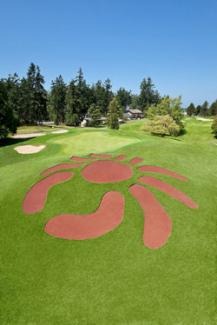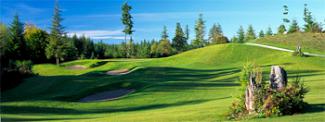Featured Golf News
Tribal Golf in Washington State on the Upswing
Across the country some of the most positive stories in golf involve the investment of Native American dollars in the industry. Nowhere is that more intense - and perhaps appreciated - than in the far-flung reaches of the Olympic Peninsula in Washington State.

No. 15 at Salish Cliffs
When more courses in the country are closing than opening, Salish Cliffs, a highly-acclaimed layout, was built on reservation property of the Squaxin Island Tribe near the logging town of Shelton.
At White Horse Golf Club in Kingston, the Suquamish Tribe spent $700,000 to soften a harsh design and is now rushing the construction of a new 24,000-square-foot clubhouse for a March opening.
On the northern tip of the peninsula in Sequim, the popular but sagging Dungeness course is enjoying an infusion of money and spirit from its owners, the Jamestown S'Klallam Tribe. The investment translates into new equipment for better course maintenance, a revamped and polished clubhouse, a new fleet of carts, and an entrance and parking lot that tells you things have changed.
So what is it about golf and Indian tribes?

The Famous Crab Claw Bunkers
at Cedars at Dungeness
Their involvement has been profound, not just the dollars that are spent but the connection with the community and quality of the improvements. Plainly, the tribes are here to stay, their goal not to satisfy stockholders with short-term profit, but to satisfy past and future generations.
"Most of the time," said Jamestown S'Klallam board member Jerry Allen, "you don't look at the golf course revenue as a true indicator of how things are going."
For the tribes, golf courses obviously offer an amenity for their nearby casinos. But they also mean, in some cases, the recouping of past reservation property as well as presenting a good community image as they host banquets and do weddings at their courses along with golf tournaments.
"The business of running a casino resonates negatively with certain parts of the community," said Allen. "The golf course handles many events that don't involve the casino. The tribe's image as a community supporter is important."

The Ninth Hole at White Horse
Allen admitted, however, that to compete with other tribes on the peninsula their Seven Cedars Casino needed to add golf to its package. "The need to have one (a golf course)," said Allen, "was pretty high."
The Squaxin Island Tribe brought in Gene Bates, who designed the popular Circling Raven course in Idaho. On 320 acres of tribal land, Bates laid out a lovely course that sits above the Tribes Little Creek Casino and its 100-room hotel.
The Suquamish Tribe, owners of White Horse, couldn't pass up the chance to add more than 300 acres contiguous to its reservation, claiming land lost long ago. Still, to this day, the reservation is less than half the size it once was.
These are good days, of course, to buy distressed properties. One estimate indicated the Suquamish paid 30 cents on the dollar to take over White Horse, a course that had five different owners in a six-month period.
Judged one of the country's best new courses when it opened in 2007, White Horse lacked the revenue to do necessary maintenance. For example, without proper and regular aerification the greens became rock-hard.
Moving quickly, the Suquamish hired Touchstone Golf LLC to run the course and esteemed golf architect John Harbottle to ease White Horse's original design. Under Harbottle's direction, 60 bunkers and hundreds of trees were removed to make the course more amenable for a wide range of players.
"People told us they played the course once," said Russell Steele, the CEO of the business arm of the Suquamish Tribe. "We wanted them to want to play it again. And again."
Allen noted the Jamestown S'Klallam Tribe had looked long and hard at building a course on their property near Diamond Point. "I knew what it cost to build a course," said Allen. "In the long run, we were better off making significant changes at Dungeness."

The Closing Hole at White Horse
In the long run is what it's all about for the tribes. "They build things to withstand the test of time," said Bill Shea, the director of golf at Cedars at Dungeness. "They never do anything on the cheap."
Like Shea, Bruce Christy - the director of golf at White Horse - was a holdover from previous ownership. The tribes take a deliberate approach when entering the golf business. "They don't rush into anything," said Christy. "But once they make a decision, they put their foot on the pedal. It is wait, wait, go."
The vision of White Horse's original owner Bob Screen was to sell real estate around a quality golf course that would eventually be augmented by tennis courts, a swimming pool and even an inn for guests. The Suquamish wanted the course for its value to visitors - casino guests - plus a place for banquets and wedding receptions.
"The most important thing for the tribe was to get back the 370 acres it had lost," said Steele.
The tribes can't - or won't - be in the business of real estate, meaning their courses won't be lined by homes. The golfer who loves solitude and an undisturbed walk in the park surely benefits.
In order to sell real estate the tribes would have to lease land for homes, something they no longer have to consider. The casinos have given them the wherewithal. They had the vision all along.
Blaine Newnham has covered golf for 50 years. He still cherishes the memory of following Ben Hogan for 18 holes during the first round of the 1966 U.S. Open at the Olympic Club in San Francisco. He worked then for the Oakland Tribune, where he covered the Oakland Raiders during the first three seasons of head coach John Madden. Blaine moved on to Eugene, Ore., in 1971 as sports editor and columnist, covering the 1972 Olympic Games in Munich. He covered five Olympics all together - Mexico City, Munich, Los Angeles, Seoul, and Athens - before retiring in early 2005 from the Seattle Times. He covered his first Masters in 1987 when Larry Mize chipped in to beat Greg Norman, and his last in 2005 when Tiger Woods chip dramatically teetered on the lip at No. 16 and rolled in. He saw Woods' four straight major wins in 2000 and 2001, and Payne Stewart's par putt to win the U.S. Open at Pinehurst. In 2005, Blaine received the Northwest Golf Media Association's Distinguished Service Award. He and his wife, Joanna, live in Indianola, Wash., where the Dungeness crabs outnumber the people.
Story Options
 |
Print this Story |
